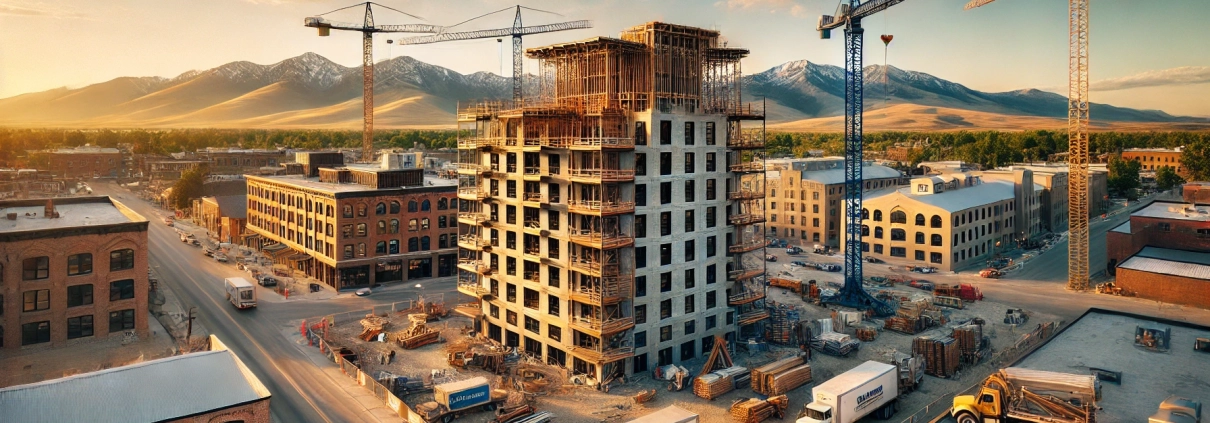Construction Financing
A short-term loan, typically with a floating interest rate, issued by a lender to finance the construction of a real estate project. The loan is paid out to the borrower in draws as construction progresses. After construction is complete and the property is fully leased and/or sold, the loan is repaid using permanent loan proceeds or proceeds from the sale of the property.
Putting “Construction Financing” in Context
Scenario Overview:
Mountain Vista Development, a regional developer specializing in adaptive reuse projects in secondary and tertiary markets, has recently acquired an aging industrial warehouse in Bozeman, MT. Located just minutes from downtown and with views of the Bridger Mountains, the property presents an ideal opportunity for redevelopment into a modern, mid-rise apartment complex. The project, named “The Lofts at Bridger,” will convert the 60,000-square-foot warehouse into 85 market-rate apartment units, targeting young professionals and students from nearby Montana State University.
Construction Financing Details:
Given the scope and nature of the redevelopment, Mountain Vista Development secured a construction loan to finance the project. The construction financing was crucial as it provided the necessary capital to transform the warehouse into a residential building.
- Loan Amount: $15 million
- Loan Term: 18 months
- Interest Rate: Floating at LIBOR + 3.5%
- Loan-to-Cost Ratio: 70%
- Disbursement Method: Draws based on construction milestones
Contextualizing Construction Financing:
Construction financing for “The Lofts at Bridger” was structured as a short-term, floating-rate loan. Mountain Vista Development negotiated an 18-month term, allowing sufficient time to complete the construction and lease up the property. The lender agreed to fund up to 70% of the total project cost, estimated at $21.4 million, meaning Mountain Vista Development had to bring $6.4 million of equity to the table.
As construction progresses, Mountain Vista receives funds in draws tied to specific milestones, such as foundation completion, framing, and final inspections. This structure minimizes the lender’s risk, ensuring that funds are only disbursed as construction advances.
For instance, upon completing the foundation and 25% of the framing, Mountain Vista might receive a draw of $3.75 million to continue the project. The interest on the loan is calculated on the outstanding balance, meaning that as Mountain Vista draws more funds, the interest expense increases.
Once construction is completed, Mountain Vista plans to lease the units quickly, given the strong demand for housing in Bozeman. The goal is to stabilize the property within six months post-construction. At stabilization, the construction loan will be refinanced into a permanent loan. The proceeds from this permanent financing will repay the construction loan in full.
Hypothetical Financial Snapshot:
- Total Project Cost: $21.4 million
- Developer’s Equity: $6.4 million
- Projected NOI at Stabilization: $1.65 million
- Permanent Loan Amount: $17 million (based on a 75% LTV at stabilization)
- Projected Stabilization Date: 6 months after construction completion
Conclusion:
In this scenario, the construction financing played a pivotal role in enabling Mountain Vista Development to undertake a significant value-add redevelopment project. The floating-rate construction loan provided the necessary capital to transform the old warehouse into a vibrant apartment community. With careful planning, Mountain Vista aims to complete construction on time, lease up the property, and transition smoothly from construction financing to permanent financing, thereby successfully executing their value-add strategy.
Frequently Asked Questions about Construction Financing in Real Estate Development
What is construction financing?
Construction financing is “a short-term loan, typically with a floating interest rate, issued by a lender to finance the construction of a real estate project.” The loan is repaid using permanent loan proceeds or sale proceeds after project completion.
How is a construction loan typically disbursed?
Funds are disbursed “in draws as construction progresses,” based on the completion of specific milestones such as foundation work, framing, and inspections.
What were the terms of the construction loan for The Lofts at Bridger?
Loan Amount: $15 million
Loan Term: 18 months
Interest Rate: Floating at LIBOR + 3.5%
Loan-to-Cost Ratio: 70%
Disbursement: Draws tied to construction milestones
How much equity did Mountain Vista Development contribute?
They contributed $6.4 million of equity toward the total $21.4 million project cost.
What happens to the construction loan after the project is completed?
After construction, the developer plans to lease the property and refinance the construction loan using “permanent loan proceeds” once the building is stabilized.
How does the floating interest rate affect the construction loan?
Interest is calculated “on the outstanding balance,” meaning that as more funds are drawn over time, the interest expense increases.
What is the projected financial outcome of the project?
Projected NOI at stabilization: $1.65 million
Permanent Loan Amount: $17 million (based on 75% LTV)
Stabilized Rentable Units: 85
Total Project Cost: $21.4 million
Target Stabilization: 6 months post-construction
Why is construction financing critical in redevelopment projects?
It provides “the necessary capital to transform” an asset—in this case, an old warehouse—into a new use, such as apartments, allowing developers to execute a value-add strategy effectively.
Click here to get this CRE Glossary in an eBook (PDF) format.

